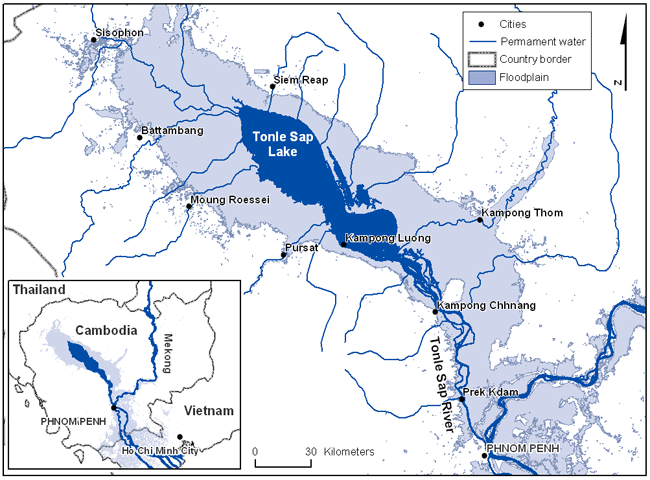The Tonle Sap Lake
The Tonle Sap Lake is a freshwater lake located in the Cambodian floodplain (see the map below!). The lake is not only the largest freshwater lake in Southeast Asia, but it is also one of the world’s most diverse ecosystems. It serves as a major food source, and is a crucial source of livelihood for the local communities living around the lake. Cambodia’s major cities (Battambang, Siem Reap, Phnom Penh) are located around the Tonle Sap Lake.
The volume of the lake fluctuates according to the season. During the monsoon or wet season (June to November), the lake expands to more than 5 times its size. During the dry season (December to April), the volume of the lake starts to decrease, its depth dropping to as low as 3 feet. The communities depend on this flooding cycle for their livelihood; during the dry season, it becomes extremely easy to catch fish as the fish that spawned during the monsoon season are forced into shallow pools of water. The flooding of the lake also creates mud banks, which provide fertile land for farming.
The locals are not the only ones who depend on the Tonle Sap Lake. The wetlands area from the flooding cycle provides a habitat for a large diversity of animal species. The surrounding mangrove forests (flooded forests) serve as protection for animals and as an essential food source for species like snakes, turtles, invertebrates and birds. So far, more than 100 fish species and 35 fish families have been recorded!
However, in 2016, The Global Nature Fund named the Tonle Sap Lake the world’s most threatened lake. Problems such as pollution and overfishing has had detrimental impacts on the lake, such as a decrease in water quality and volume. This in turn has severely impacted the local communities’ livelihood, as well as other animal species that rely on the Tonle Sap for their survival.



Recent Comments